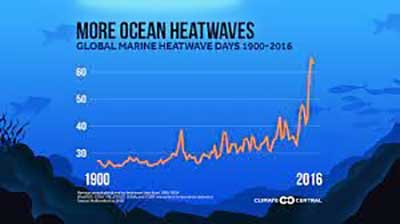Relevance: GS-3: Conservation, Environmental Pollution and Degradation; Disaster and Disaster Management
Key Phrases: MHWs, Global Warming, El Nino, Intergovernmental Panel on Climate Change, Samudrayan, OCEANSAT, Per drop more crop,
Why in News?
- Marine heat waves (MHW), which are periods of increased temperatures over seas and oceans, in the Indian Ocean region have increased significantly in the past few decades, according to a new report.
- The phenomenon is impacting the Indian monsoon, the study published in the journal JGR Oceans showed.
About MHWs
- Reason behind MHWs
- Such heat waves are caused by an increase in the heat content of oceans, especially in the upper layers. Worldwide, they are one of the major results of human-induced global warming.
- What are MHWs?
- During an MHW, the average temperatures of the ocean surface (up to a depth of 300 feet) goes 5-7 degrees Celsius above normal.
- Around 90 % of the warming caused by greenhouse gas emissions is absorbed by the oceans.
- The year 2021 broke all previous records for ocean heat, according to the National Oceanic and Atmospheric Administration of the United States.
- The increase in marine heat waves was due to rapid warming in the
Indian Ocean and strong El Nino events, the study led by Roxy Mathew
Koll from the Indian Institute of Tropical Meteorology (IITM),
Pune, found.
- El Nino is one phase of the El Nino Southern Oscillation (ENSO) phenomenon which has a generally warming effect on the world’s ocean and land surfaces.
- In 2015-16, the world witnessed a strong El Nino event that had
wide-ranging impacts on weather conditions around the world, including
marine heat waves.
- These events cause habitat destruction due to
- Coral bleaching,
- Seagrass destruction and
- Loss of kelp forests, affecting the fisheries sector adversely
- These events cause habitat destruction due to
- An underwater survey showed 85 % of corals in the Gulf of Mannar near
the Tamil Nadu coast got bleached after the marine heatwave in May 2020,
they highlighted.
- Marine heatwaves in the tropical Indian Ocean are the least understood, though recent studies have reported their occurrence and impacts in the world’s oceans.
- A marine heat wave spanning over 6.5 million square kilometres had affected the Pacific Ocean off the coast of the state of Oregon in the United States in September 2019.
- In the Indian Ocean, the worst-affected were its western part and
northern Bay of Bengal, according to the study.
- The number of MHWs in the west Indian ocean increased by around 1.5 events per decade between 1982 and 2018.
- The occurrences went up by around 0.5 events per decade in north Bay of Bengal in the same period.
- There were a total of 66 events in the west Indian Ocean and 94 in the north Bay of Bengal in the 36 years.
Impact on Monsoon

- The marine heat waves in the Indian Ocean are also majorly
impacting the southwest monsoon — the main rain-bearing system over the
Indian subcontinent.
- Of the net sown area of around 140 million hectares (mn ha), close to half (68.4 mn ha) is irrigated whereas the rest is rainfed (Agri Census 2015-16 data)
- The MHWs in the two worst-hit regions reduce monsoon rainfall over
central India, the study established.
- The occurrence in north Bay of Bengal increases rainfall over the southern peninsular area, it added.
- This is the first time a study has demonstrated a close link between marine heatwaves and atmospheric circulation and rainfall
- Climate model projections suggest further warming of the
Indian Ocean in the future.
- This will very likely intensify the marine heatwaves and their impact on the monsoon rainfall
- As per Intergovernmental Panel on Climate Change, if current
human carbon emissions are not reduced:
- A one-in-hundred-days event (at pre-industrial carbon dioxide levels) is projected to become a one-in-four-days event by 2031–2050 and
- A one-in-two-days event by 2081–2100
- The frequency, intensity and area covered by the marine heatwaves are
increasing.
- There is a need to enhance our ocean observational arrays to monitor these events accurately.
- It is also imperative to update our weather models to skilfully predict the challenges presented by a warming world
Government measures to understand, analyse and respond to MHWs
- Monitoring
- Satellite monitoring to measure temperature changes
- OCEANSAT series of satellites to measure Sea Surface Temperature (SST)
- OCEANSAT 3 (/EOS-06) Satellite was expected to be launched in January 2022
- Deep Ocean Mission
- Satellite monitoring to measure temperature changes
- Analysis
- National Supercomputing Mission to build high performance computers which can analyse the data collected from various resources in a better way
- Data collation to derive advantages from Big Data
- Response
- Mitigating Emissions through National Action Plan for Climate Change (8 submissions)
- Adapting to MHWs’ effect on Monsoon
- By increasing efficient usage of water with initiatives like Per Drop More Crop
- By increasing the water availability with water conservation activities like mission kakatiya (Telangana), Mission Jal Shakti, Atal Bhujal Yojana.
Source: Down to Earth
Mains Question:
Q. Define Marine Heat Waves (MHWs) and its effect on Indian Monsoon. Also mention the mitigation and adaptation measures to tackle them.









